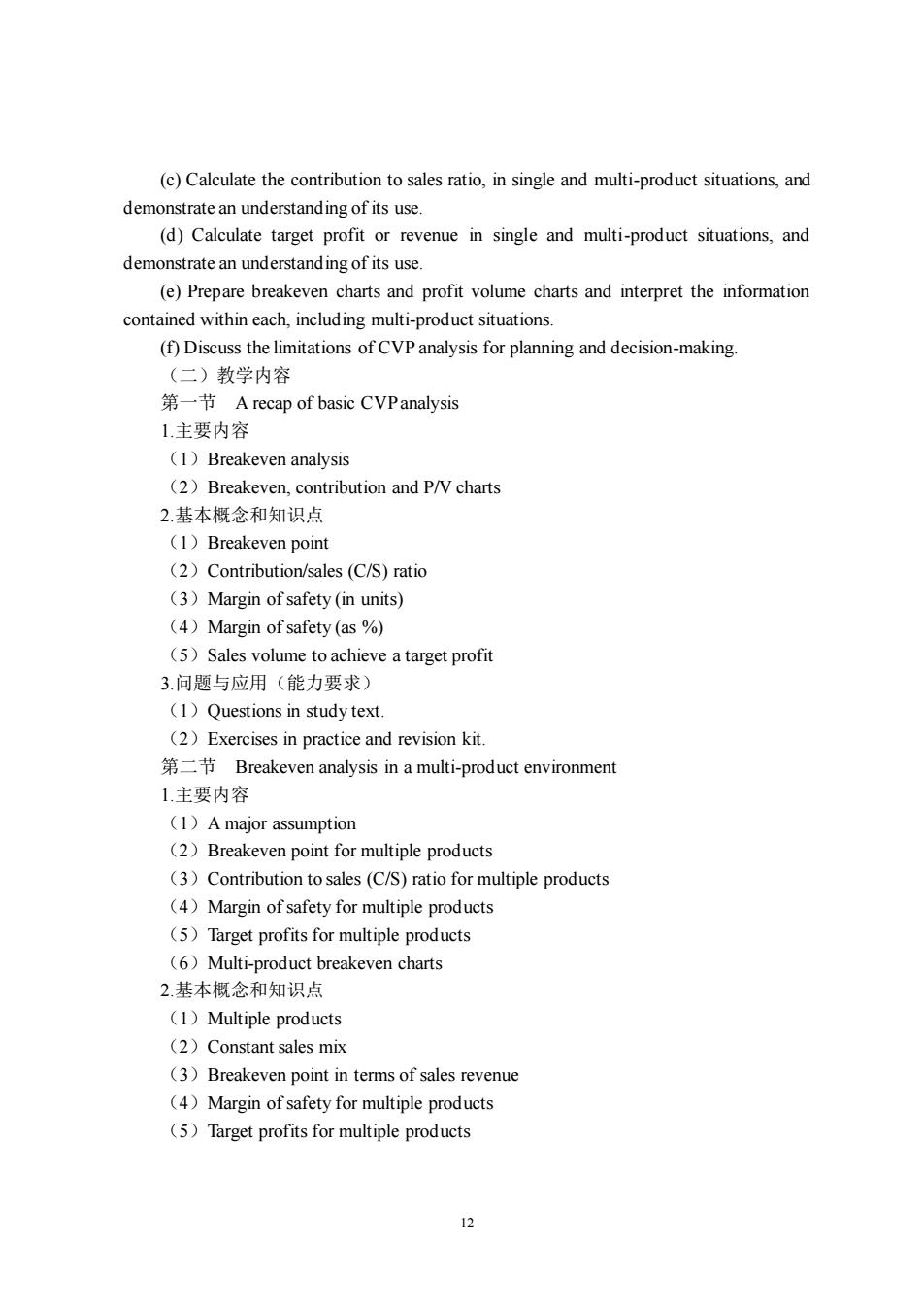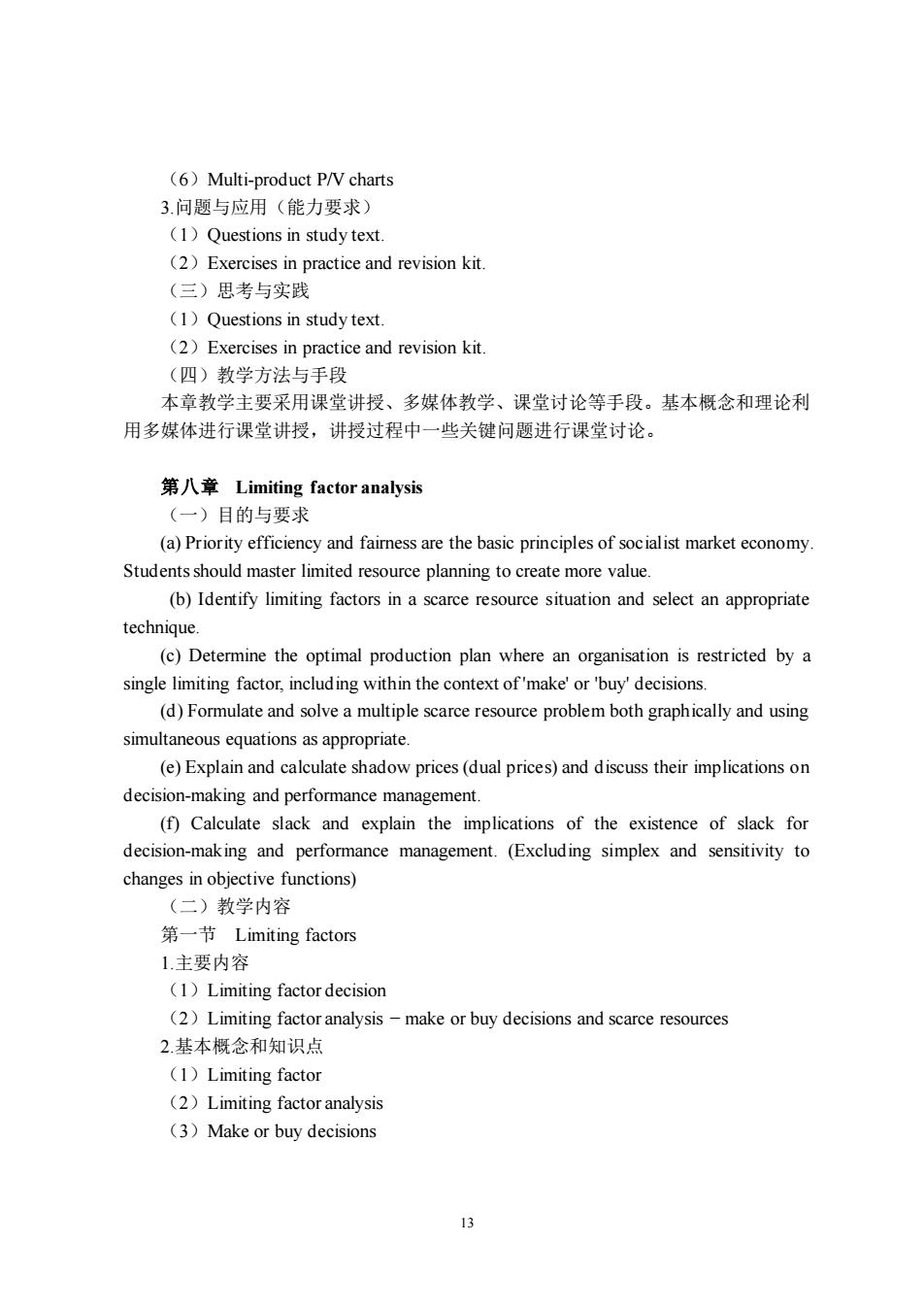
(1)Environmental concem and performance (2)Defining environmental costs (3)Identifying environmental costs (4)Controlling environmental costs 2.基本概念和知识点 (1)Environmental costs (2)Environmental management accounting(EMA) 3问题与应用(能力要求) (1)Questions in study text (2)Exercises in practice and revision kit. 第二节Accounting for environmental costs 1主要内容 (1)Input/output analysis (2)Flow cost accounting (3)Environmental activity-based costing (4)Environmental life cycle costing 2基本概念和知识点 (1)Input/output analysis (2)Flow cost accounting (3)Environmental activity-based costing (4)Environmental life cycle costing 3.问题与应用(能力要求) (1)Questions in study text (2)Exercises in practice and revision kit. (三)思考与实践 (1)Questions in study text. (2Exercises in practice and revision kit (四)教学方法与手段 本章教学主要采用课堂讲授、多媒体教学、课堂讨论等手段。基本概念和理论利 用多媒体进行课堂讲授,讲授过程中一些关键问题进行课堂讨论。 第七章Cost volume profit analysis (一)目的与要求 (a)Explain the nature of CVP analysis. (b)Calculate and interpret breakeven point and margin of safety. 11
11 (1)Environmental concern and performance (2)Defining environmental costs (3)Identifying environmental costs (4)Controlling environmental costs 2.基本概念和知识点 (1)Environmental costs (2)Environmental management accounting (EMA) 3.问题与应用(能力要求) (1)Questions in study text. (2)Exercises in practice and revision kit. 第二节 Accounting for environmental costs 1.主要内容 (1)Input/output analysis (2)Flow cost accounting (3)Environmental activity-based costing (4)Environmental life cycle costing 2.基本概念和知识点 (1)Input/output analysis (2)Flow cost accounting (3)Environmental activity-based costing (4)Environmental life cycle costing 3.问题与应用(能力要求) (1)Questions in study text. (2)Exercises in practice and revision kit. (三)思考与实践 (1)Questions in study text. (2)Exercises in practice and revision kit. (四)教学方法与手段 本章教学主要采用课堂讲授、多媒体教学、课堂讨论等手段。基本概念和理论利 用多媒体进行课堂讲授,讲授过程中一些关键问题进行课堂讨论。 第七章 Cost volume profit analysis (一)目的与要求 (a) Explain the nature of CVP analysis. (b) Calculate and interpret breakeven point and margin of safety

(c)Calculate the contribution to sales ratio,in single and multi-product situations,and demonstrate an understanding of its use. (d)Calculate target profit or revenue in single and multi-product situations,and demonstrate an understanding of its use. (e)Prepare breakeven charts and profit volume charts and interpret the information contained within each,including multi-product situations. (f)Discuss the limitations of CVP analysis for planning and decision-making (二)教学内容 第一节A recap of basic CVPanalysis 1主要内容 (1)Breakeven analysis (2)Breakeven.contribution and P/V charts 2.基本概念和知识点 (1)Breakeven point (2)Contribution/sales (C/S)ratio (3)Margin of safety (in units) (4)Margin of safety(as%) (5)Sales volume to achieve a target profit 3.问题与应用(能力要求) (1)Questions in study text. (2)Exercises in practice and revision kit 第二节Breakeven analysis in a multi--product environment 1主要内容 (1)A major assumption (2)Breakeven point for multiple products (3)Contribution to sales(C/S)ratio for multiple products (4)Margin of safety for multiple products (5)Target profits for multiple products (6)Multi-product breakeven charts 2.基本概今和知识点 (1)Multiple products (2)Constant sales mix (3)Breakeven point in terms of sales revenue (4)Margin of safety for multiple products (5)Target profits for multiple products
12 (c) Calculate the contribution to sales ratio, in single and multi-product situations, and demonstrate an understanding of its use. (d) Calculate target profit or revenue in single and multi-product situations, and demonstrate an understanding of its use. (e) Prepare breakeven charts and profit volume charts and interpret the information contained within each, including multi-product situations. (f) Discuss the limitations of CVP analysis for planning and decision-making. (二)教学内容 第一节 A recap of basic CVP analysis 1.主要内容 (1)Breakeven analysis (2)Breakeven, contribution and P/V charts 2.基本概念和知识点 (1)Breakeven point (2)Contribution/sales (C/S) ratio (3)Margin of safety (in units) (4)Margin of safety (as %) (5)Sales volume to achieve a target profit 3.问题与应用(能力要求) (1)Questions in study text. (2)Exercises in practice and revision kit. 第二节 Breakeven analysis in a multi-product environment 1.主要内容 (1)A major assumption (2)Breakeven point for multiple products (3)Contribution to sales (C/S) ratio for multiple products (4)Margin of safety for multiple products (5)Target profits for multiple products (6)Multi-product breakeven charts 2.基本概念和知识点 (1)Multiple products (2)Constant sales mix (3)Breakeven point in terms of sales revenue (4)Margin of safety for multiple products (5)Target profits for multiple products

(6)Multi-product P/V charts 3.问题与应用(能力要求) (1)Questions in study text. (2Exercises in practice and revision kit (三)思考与实践 (1)Questions in study text. (2)Exercises in practice and revision kit. (四)教学方法与手段 本章教学主要采用课堂讲授、多媒体教学、课堂讨论等手段。基本概念和理论利 用多媒体进行课堂讲授,讲授过程中一些关键问题进行课堂讨论。 第八章Limiting factor analysis (一)目的与要求 (a)Priority efficiency and fairness are the basic principles of socialist market economy. Students should master limited resource planning to create more value (b)Identify limiting factors in a scarce resource situation and select an appropriate technique (c)Determine the optimal production plan where an organisation is restricted by a single limiting factor,including within the context of'makeor buy decisions (d)Formulate and solve a multiple scarce resource problem both graphically and using simultaneous equations as appropriate (e)Explain and calculate shadow prices(dual prices)and discuss their implications on decision-making and performance management (f)Calculate slack and explain the implications of the existence of slack for decision-making and performance management.(Excluding simplex and sensitivity to changes in objective functions) (二)教学内容 第一节Limiting factors 1.主要内容 (1)Limiting factor decision (2)Limiting factor analysis-make or buy decisions and scarce resources 2.基本概念和知识点 (1)Limiting factor (2)Limiting factor analysis (3)Make or buy decisions 13
13 (6)Multi-product P/V charts 3.问题与应用(能力要求) (1)Questions in study text. (2)Exercises in practice and revision kit. (三)思考与实践 (1)Questions in study text. (2)Exercises in practice and revision kit. (四)教学方法与手段 本章教学主要采用课堂讲授、多媒体教学、课堂讨论等手段。基本概念和理论利 用多媒体进行课堂讲授,讲授过程中一些关键问题进行课堂讨论。 第八章 Limiting factor analysis (一)目的与要求 (a) Priority efficiency and fairness are the basic principles of socialist market economy. Students should master limited resource planning to create more value. (b) Identify limiting factors in a scarce resource situation and select an appropriate technique. (c) Determine the optimal production plan where an organisation is restricted by a single limiting factor, including within the context of 'make' or 'buy' decisions. (d) Formulate and solve a multiple scarce resource problem both graphically and using simultaneous equations as appropriate. (e) Explain and calculate shadow prices (dual prices) and discuss their implications on decision-making and performance management. (f) Calculate slack and explain the implications of the existence of slack for decision-making and performance management. (Excluding simplex and sensitivity to changes in objective functions) (二)教学内容 第一节 Limiting factors 1.主要内容 (1)Limiting factor decision (2)Limiting factor analysis − make or buy decisions and scarce resources 2.基本概念和知识点 (1)Limiting factor (2)Limiting factor analysis (3)Make or buy decisions